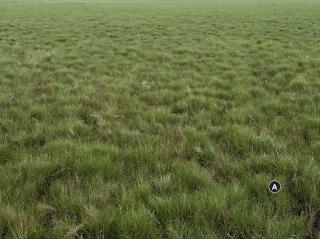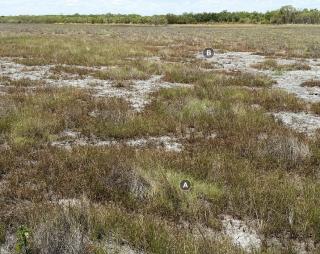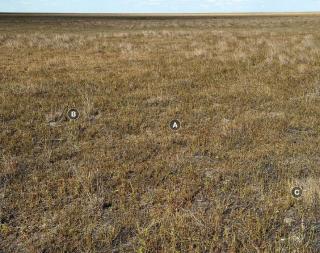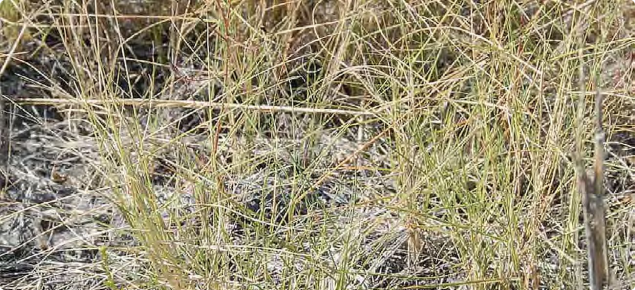Saltwater couch pastures
These pastures are part of the Sandy soil group pastures, and perennial saltwater couch grass (Sporobolus virginicus) is the identifier grass. Use the interactive key to pasture condition to help identify pasture type.
Pastoral value
Salt water couch pastures in good or fair condition are highly productive, stable and resilient under grazing.
The forage value is adequate for livestock growth during the wet season, however salt water couch pastures should be spelled over the wet season, as in many areas the clay soils will be waterlogged. Hoof impacts from cattle will damage soil structure and pasture, and cattle will will preferentially stay away from boggy areas if they have the choice. During the dry season the palatability and quality of the forage declines, but still provides good grazing and a maintenance ration for stock.
Continuous heavy grazing will quickly remove the more palatable legumes and other forbs that provide better nutrition for stock.
These pastures can tolerate occasional burning – once every three to five years – but generally burning will not benefit pastures. Salt water couch pastures can tolerate high levels of salinity and occasional inundation.
Management
Grazing
Salt water couch pastures are highly productive pastures if managed correctly: they are of most use to stock when they are grazed during the dry season and spelled over the wet season. During the wet season cattle should be moved to the less productive Pindan pastures or soft spinifex pastures.
Overgrazing will lead to a decline in the amount of salt water couch and an increasing proportion of less desirable grasses and samphire. When in poor condition with surfaces exposed and vulnerable to wind erosion, a complete spell is recommended until the ground cover of desirable species improves to at least fair condition. Poor condition salt water couch pastures with ground cover should, at the very least, be spelled from late in the dry season and throughout the wet season.
Fire
We do not recommend burning these pastures. If they do get burnt, cattle should be moved off the pastures until the plants are big enough that they will not be pulled out by grazing. This will normally take about two months during the growing season.
Saltwater couch carrying capacity
| Condition | Hectares per cattle unit |
|---|---|
| Good | 10 |
| Fair | 20 |
| Poor | 100 |
Distribution and soil type
Saltwater couch pastures are tussock grasslands with some halophytic shrubs, dominated by saltwater couch. These pastures occur on broad, flat, saline, coastal plains located above the tidal influence or cut off by coastal dunes. They are found on areas of saline, clay soils on the marine plains from the Broome area south. Small areas also occur on marine plains along the northern coastline. It is the major pasture of the Anna, Mannerie, and Roebuck land systems, an important component on the Gourdon land system, and a minor component on the Carpentaria land system.
These land systems are mapped in NRInfo:
- First choose/tick Pastoral Land Systems in Pastoral – Land Systems
- then click the filter icon
- then click Pastoral Land Systems (name)
- then choose the Map Unit Name from the Pastoral Land Systems (name) drop-down list
Vegetation structure and composition
Structure and composition are variable and a function of salinity, micro-topography and prevailing climatic conditions. Pastures are tussock grasslands with some halophytic shrubs. In each case the ground storey is dominated by salt water couch (Sporobolus virginicus).
Trees and shrubs are isolated, with a projected foliar cover (PFC) of less than 2.5%), and tend to occur on the margins or on slightly raised areas. The tree and tall shrub layer is dominated by black wattle (Acacia ampliceps) or coastal paperbark (Melaleuca alsophila).
Halophytic shrubs are a normal component of salt water couch pastures, tending to occur in patches where the salt content of the soil is elevated. Samphires (Tecticornia spp.) and frankenias (Frankenia spp.) are the common halophytes occurring in salt water couch pastures of the Kimberley.
The perennial grass layer is dominated by salt water couch. Rice grass (Xerochloa laniflora) is usually present in the pasture, but other grasses such as buffel (Cenchrus ciliaris), coastal bluegrass (Bothriochloa ewartiana), silky browntop (Eulalia aurea), river couch (Cynodon dactylon), native millet (Panicum decompositum) and sickle lovegrass (Eragrostis falcata) are also common.
With increasing salinity, pure salt water couch pastures grade into salt water couch – samphire pastures. Bare areas in the pastures will increase along the same salinity gradient, so bear this in mind when assessing pasture condition.
Assessing pasture condition
The condition of these pastures is assessed by observing the degree of ground cover (% basal cover) afforded by the grass tussocks, the vigour of the tussocks, age structure of the stand, the proportion of undesirables in the stand and the condition of the soil surface.
Salt water couch pastures in good condition will be dominated by salt water couch. Basal cover may be 3 to 5% or more of the soil surface. Other grasses will include some rice grass and native millet. Some samphire may be present. Some bare ground may be present, but the sprawling nature of the vegetation in these pastures creates the effect of a carpeted landscape when in good condition.
In fair condition the distance between butts of desirable grasses will increase. Basal cover will decrease to 1 to 3%. The proportion of the intermediate grasses such as sickle lovegrass and rice grass will increase, and samphire will increase to above one third of the stand. Other intermediate species such as speedy weed (Flaveria trinervia [syn. F. australasica) form a significant part of the stand. Undesirables such as lippia (Phyla nodiflora) will become a significant part of the stand. Small patches of bare ground may become obvious between the plants when these pastures are in fair condition.
In poor condition there may be isolated butts of salt water couch present, but samphire and bare ground make up a large proportion of the surface. The intermediate grasses such as chloris (Chloris spp.), sickle lovegrass, rice grass and woollybutt (Eragrostis eriopoda) make up an increasing proportion of the total ground cover. The bare soil surfaces may be vulnerable to wind erosion late in the dry season.
Rangeland condition assessment (2000–2009) and long-term monitoring data (WARMS) indicates that salt water couch pastures in the Kimberley are predominately in good to fair condition (around 95%), with the remaining pastures in poor condition.
With overuse, the proportion of salt water couch in the pasture will decrease and the amount of other species such as samphire may initially increase. As grazing pressure increases the samphire will decrease as it is trampled and more bare ground will be exposed.
Soil erosion is not usually associated with a decline in condition in these pastures, though wind erosion may occur towards the end of the season if grazing continues when the pastures are in poor condition and soil surfaces are exposed.
Pasture condition rating
Good: Saltwater couch dominates these pastures in good condition. Other grasses include rice grass and native millet, and some samphire may be present. Some bare ground may be visible, but the sprawling nature of the vegetation in these pastures creates the effect of a carpeted landscape when in good condition.
With increasing salinity, pure saltwater couch pastures grade into salt water couch/samphire pastures. Bare areas will increase along the same salinity gradient so bear this in mind when assessing pasture condition.

Fair: Overuse decreases the proportion of saltwater couch in the pasture, and other species, such as samphire, may initially increase. If grazing pressure remains heavy, the samphire will also decrease as it is trampled and more bare ground will be exposed. In fair condition, the proportion of the intermediate grasses, such as rice grass, will increase along with other intermediate species, such as speedy weed, and undesirable species, such as lippia.

Poor: In poor condition there may be isolated desirable grasses present, but samphire and bare ground make up a large proportion of the surface. Intermediate grasses, such as chloris, sickle lovegrass, rice grass and woollybutt grass, may be present. The bare soil surfaces will be vulnerable to wind erosion late in the dry season under grazing.

Associated plants
| Common name (link to DPIRD species page) | Scientific name (link to FloraBase) | Life form |
|---|---|---|
| Desirable species | ||
| Saltwater couch, marine couch | perennial grass | |
| perennial grass | ||
| perennial grass | ||
| Coastal bluegrass | perennial grass | |
| Intermediate species | ||
| Sickle lovegrass | perennial grass | |
| River couch | perennial grass | |
| Boat panic | annual or perennial grass | |
| Speedy weed | annual | |
| Samphires | Tecticornia spp. | perennial herb or shrub |
| Frankenia spp. | perennial herb | |
| Undesirable species | ||
| Lippia | perennial herb | |
| Quena | perennial herb |

